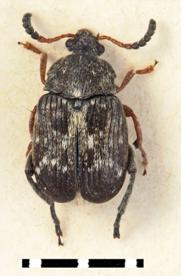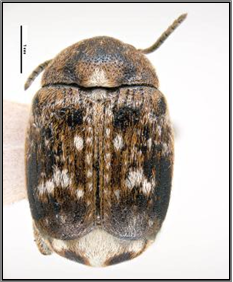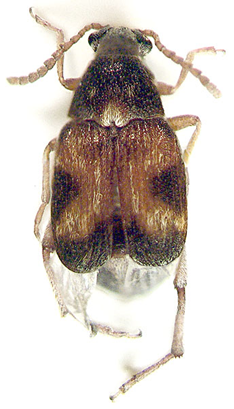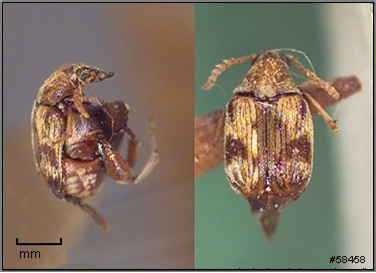Insects - lentil
Contributors to this page: ICARDA, Aleppo, Syria (Siham Asaad, Abdulrahman Moukahal).
|
Contents: |
Scientific names
Bruchus lentis Frölich & Bruchus ervi Froel
Significance
B. ervi is a slightly elongate beetle with a body length of 3-3.8 mm. The elytra are black with light brown hairs and whitish spots. B. lentis adults are 3-3.5 mm long and have dense, grey reddish hairs on the back, marked with several whitish spots. The larvae are white-yellowish with a dark brown head.
Symptoms
The first symptom is a small dark pinhole or penetration dot on the seed at the time of harvest. If the seeds are opened the larva is found inside. Later a window appears on the seed and most of the seed is eaten out by the Bruchus larva.
Hosts
This beetle is specific to lentil.
Geographic distribution
Bruchus ervi occurring in Europe, North Africa and Southwest Asia, and Bruchus lentis in the USA, Europe, North Africa, Southwest Asia and India.
Biology and transmission
B. ervi is a slightly elongate beetle with a body length of 3-3.8 mm. The elytra are black with light brown hairs and whitish spots. B. lentis adults are 3-3.5 mm long and have dense, grey reddish hairs on the back, marked with several whitish spots. The larvae are white-yellowish with a dark brown head.
The adults move into lentil fields at the time of flowering where they feed on nectar and pollen. Ovary development and copulation occur after feeding. The females glue their elongate, yellow transparent eggs to the outside of the young pods. Upon hatching, the tiny larva penetrates the pod wall, burrows through the pod until it reaches the developing seed, enters the seed and feeds on its contents. The larva grows slowly and requires about 6 weeks until it is fully grown. Before pupation the larva eats an exit passage to the surface of the seed, leaving only a thin circular window (the epidermal membrane) intact. After pupation the emerging adult opens this membrane and leaves the seed. Adults may re-enter the seed for hibernation or hibernate in other protected places, until lentil flowering next season.
Detection/indexing method at ICARDA
- Visual inspection
Treatment/control
- At harvest, inspect seeds for small penetration holes and windows. Fumigate infested seeds before storage with phosphine (Phostoxin).
- Do not plant infested seeds.
-
If high infestations occur, apply insecticides to ensure clean seeds for export or seed production. Two applications, at early to 50% flowering and 2 weeks later, of the following insecticides provide adequate control:
- Endosulfan (Thiodan 35) at 4 ml/L
- Alpha capamethrin (Fasctac EC 10) at 0.25 ml/L
- Methyl parathion (Metyphon EC 50) at I ml/L.
Procedure followed at the centers in case positive test
- Fumigation
References and further reading
http://www.icarda.org/Publications/Field_Guides/Lentil/Lentil.htm#Lent7.Html
http://www.padil.gov.au/viewPestDiagnosticImages.aspx?id=376

Bruchus ervi (photo: PaDIL, ICARDA) |

Bruchus lentis(photo: PaDIL, ICARDA) |
Cowpea seed beetle, Adzuki bean seed beetle.
Scientific names
Callosobruchus maculatus Fabricius and C. chinensis (L.)
Significance
The Callosobruchus beetles are principally a serious pest of stored products under hot dry conditions; complete destruction of grain and pulses may take place in a short time. In humid climates, the rates of increase of its competitors are so much greater that it has difficulty in establishing itself.
Symptoms
The larval stage of the weevil tunnel and develop within the beans. They may consume nearly the entire bean contents. Pupation occurs in the beans and adults emerge through a round hole in the seed coat. Damage is a combination of the feeding and contamination.
Hosts
They attack several legumes in storage, chickpea (Cicer arietinum), arhar (Cajanus cajan), green gram (Vigna radiata), pea (Pisum sativum) and kidney bean (Phaseolus vulgaris) seeds. On lentil, C. chinensis is the most common.
Geographic distribution
Both species are widespread and found in all continents with subtropical or tropical conditions.
Biology and transmission
The eggs are glued to the bean or the pod. On hatching the larvae bores into the seed where it makes a translucent 'window' in the seed before pupating. The larval and pupal stages are spent inside the bean. The adult emerges through the 'window' leaving a neat round hole. Infestations can begin in the field. Adults move to bean fields from trash beans left in sacks, harvesters, planters, or feed areas. The cowpea weevil readily attacks dried beans; thus this weevil can be a serious storage pest. Bean weevil infestations can also start in the field and may also originate from trash beans. As with the cowpea weevil, bean weevil will attack dried beans and can be a serious pest in stored beans. Broad bean weevil infestations also start in the field, but this pest is not a storage problem.
Detection/indexing method in place at the CGIAR Center at ICARDA
- Visual inspection
Treatment/control
- Cleanliness in storage: Stores should be cleaned from all residues of grains, straw and flour and be de-infested by spraying walls with malathion,
- Sacks, thresher and transportation vehicles also should be cleaned.
- Seeds stored for food/feed can be fumigated with phospine (Phostoxine) available as 0.6 g pellets and 3 g tablets. The recommended dosage is 0.5-1 tablet/m3 with an exposure time of 2-4 and 3-5 days for pellets and tablets, respectively. The major advantages of Phostoxin are that it controls all insect stages, has no residues, does not affect flavor or germination and is easy to handle.
- Seeds stored for planting can be treated with insecticides such as Actellic at 4-10 ppm a.i. (0.5 g/kg seed) or malathion at 10 ppm a.i., which will protect the seeds for several months.
- In traditional methods, small quantities of seed stored for human consumption are often mixed with different vegetable oils or other substances. Mixing seeds with olive oil and salt (5 ml and 20 g/kg seed) or Neem seed oil (3 ml/kg seed) can provide adequate control for a period of 3-4 months.
Procedure followed at the center in case of positive test
- Fumigation
References and further reading
- http://www.icarda.org/Publications/Field_Guides/Lentil/Lentil.htm#Lent7.Html
- http://www.infonet-biovision.org/default/ct/82/pests
- http://agspsrv34.agric.wa.gov.au/Ento/pestweb/Query1_1.idc?ID=-1771861620
- http://www.zin.ru/Animalia/coleoptera/rus/calmacdk.htm
- http://www.infonet-biovision.org/default/ct/82/pests
- http://agspsrv34.agric.wa.gov.au/ento/icdb/speciescompspec.idc?mnuorder=Coleoptera&mnufamily=Chrysomelidae&mnugenus=Callosobruchus.

Callosobruchus maculatus (photo: www.zin.ru) |

Callosobruchus maculatus (photo: |

Callosobruchus chinensis (photo: agspsrv34.agric.wa.gov.au) |
Comments
- No comments found





Leave your comments
Post comment as a guest